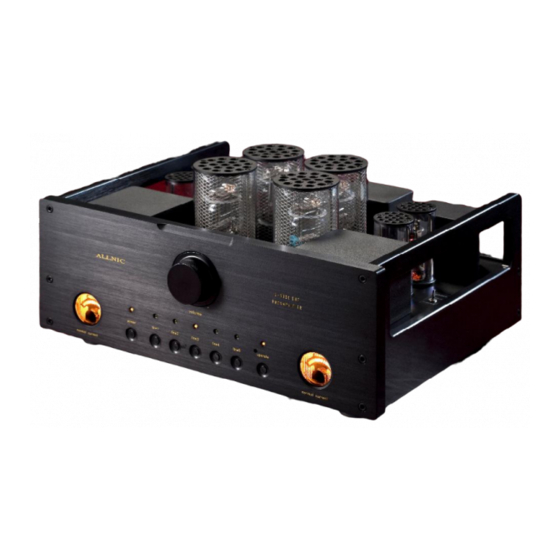ALLNIC AUDIO L-5000 DHT Посібник користувача - Сторінка 7
Переглянути онлайн або завантажити pdf Посібник користувача для Підсилювач ALLNIC AUDIO L-5000 DHT. ALLNIC AUDIO L-5000 DHT 14 сторінок. Line stage preamplifier

DO NOT place the unit near a strong light or heat
source.
DO NOT place anything heavy on the unit.
DO NOT allow rubber or vinyl materials to rest on
the unit's chassis for long periods of time. This
could discolour the metal.
DO place the unit on a shelf or stand that is stable
and not subject to vibration or sudden shock.
DO consider using a high quality power cord and
inter-connects, both inputs and outputs. The L-
5000 is a highly sensitive piece of electronic
equipment designed for neutrality and will output
what you put into it.
DO try to place the L-5000 DHT away from major
sources of RFI and EMI; though well shielded, the L-
5000 DHT will function best away from large power
transformers and other sources of such
interference.
B.
POWER CONNECTION
The L-5000 DHT uses a standard three prong male IEC
connection for AC input. You need to use a power cord with
a female three prong IEC connector at one end.
To the left of the IEC connector (facing the left side of the
unit as in Figure 1), there is a power on-off switch. Leave
this switch in the OFF position – that means the switch is
pressed "down" at the bottom - while you make all initial
connections.
The L-5000 DHT you have purchased is set internally for AC
110/120 volt – 60 HZ operation. There is no way to change
this to another AC setting without return of the unit to the
factory for re-wiring, at the owner's cost, including
transport both directions.
C.
INPUTS
There are five (5) inputs. Line 1 and Line 2 are balanced
connections (XLR type connectors). The remaining 3 line
inputs are RCA type single-ended connections. None of the
inputs is intended especially for connection to any
particular device.
NO PHONO STAGE - The L-5000 DHT is a line stage
preamplifier and does NOT have a built in phono
preamplifier section. You will need a phono preamplifier if
you want to use a turntable with the L-5000 DHT. You can
connect your phono preamplifier to any of the five inputs,
provided you have the appropriate types of connections or
adaptors.
The L-5000 DHT has been designed and manufactured to
work most synergistically with Allnic Audio phono
preamplifiers, pre-preamplifiers, equalization and power
amplification products.
D.
OUTPUTS
The L-5000 DHT has three pairs of outputs. Two (2)
output pairs are balanced (i.e., separate ground), using
XLR connectors; one (1) pair is unbalanced, using RCA
type connectors.
One pair of the balanced (XLR) outputs is a "Record Out"
("rec out"). It is a straight pass-through, unaffected by the
L-5000 DHT's circuitry, and provides no gain.
The other two pairs of outputs are intended for
connection to a power amplifier. On the back panel of the
L-5000 DHT there is a switch to select either the balanced
or single-ended connections. This selection switch is at
the top centre of the rear panel and labeled "unbalanced
output" (see Figure 2). Please set the output selection
switch to the output connection you are using. If you set
the switch to "balanced" (i.e., XLR – switch pushed to the
right, looking from the rear) and then connect your cables
to the RCA outputs ("main out 2"), audible hum will be
introduced.
You may use both the balanced and single-ended RCA
outputs at the same time; for example, if you run one
pair to your stereo amplifier and the other to a powered
subwoofer (or a pair of them). In such a case, set the
output selection switch to unbalanced (RCA – switch
pushed to the left). This will avoid the introduction of
hum.
E.
PHASE SWITCH
On the right hand side of the top deck of the chassis,
there is a phase switch. This switch is a 180 degree phase
switch; phase is either normal or inverted one hundred
percent, depending on the switch position. On initial
connection, set the switch to normal. Depending on the
phase your sources output and their facilities with regard
to phase, you may want to switch to inverted phase
sometimes. Phase issues generally will result in lack of
bass and/or focus of the stereo image (See Figure 3).
F.
REMOTE CONTROL
The remote control provides the ability to remotely:
Select the line source input using either the
numbered buttons or the horizontal arrow buttons
7
